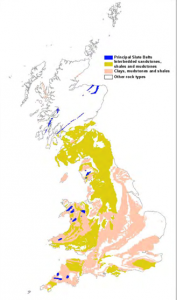Root-induced subsidence occurs in shrinkable soils, which are mainly clays, or clay-based matrixes. In the UK there are a great deal of different soil types, and layers of differing soils. We need to differentiate between bedrock (i.e. the main older ground type forming the earth’s crust), superficial deposits (i.e. soils laid down on top of the bedrock over time – which can be many metres thick), and topsoil (i.e. decayed organic matter usually within the top 0.5m or so). Occasionally there are no superficial deposits and the topsoil is directly on the bedrock, and in some areas (such as the Burran in Western Ireland), there is not even any topsoil – just rock. Topsoil and bedrock are rarely shrinkable so it is the superficial deposits with which we are concerned when assessing the risk of root-induced subsidence. So where are the risk areas? Mudstone is a material made from compressed clays and silts. Silt is deposited by rivers and lakes and comprises eroded minerals together with topsoils and organic debris (dead plants and animals). Most material that gets washed down the sides of hills ends up as silt at the bottom of rivers lakes or seas. Sea beds are similar as they accumulate all decaying sea-life. Silts turn into clays by a variety of ways mostly invol ving chemical actions (hydrolysis) and water movement. Clay is much finer than silt and it is this that gives rise to the shrink-swell characteristics that cause subsidence. Under pressure from water, ice or soil above, clay becomes mudstone as the pores are squeezed shut, expelling trapped water. Under further pressure, mudstone becomes shale, and then finally slate. Slate, and shale are so compressed that they are in all practicality non-shrinkable, having undergone irreversible metamorphosis. Mudstone is mid-way between clay and shale in terms of plasticity. However, whilst slate and shale have undergone permanent changes, mudstone can revert back to clay when exposed to weathering (i.e. rainfall). It is frequently found, therefore, that the top 1-2 metres of mudstone has in fact become shrinkable clay again because of its proximity to the surface of the ground. Shrinkability reduces with depth and eventually disappears as the effects of surface rainfall diminish with depth. Mudstone is often found interbedded with sandstone and coal seams and is found widely across England and Wales. In particular in the North of England, Midlands and Wales, mudstone is encountered within the Pennine Coal Measures (Upper, Middle and Lower), and as Mercia Mudstone (previously known as Keuper Marl). It is notable that with climate change, properties in the Midlands and the North are experiencing significantly greater numbers of clay shrinkage subsidence cases. Not so long ago this type of subsidence was considered largely a problem of south-east England, large parts of which are covered with thick layers of high plasticity clay. However, it is only the upper 1-3m of the soil which is of significance in root-induced subsidence because that is the zone where most trees root. So whilst desiccation on mudstone is generally in the uppermost clayey layers, and not deep-seated (as it can be on London clay for example), with higher temperatures now being experienced generally, properties in these more northerly areas are now experiencing subsidence problems more commonly. They are still at a lesser level of intensity and spread than in the south-east though. Bob Gibson, FFPWS – Subsidence Consultant, Structural Engineer, Building Surveyor B&SC – director
ving chemical actions (hydrolysis) and water movement. Clay is much finer than silt and it is this that gives rise to the shrink-swell characteristics that cause subsidence. Under pressure from water, ice or soil above, clay becomes mudstone as the pores are squeezed shut, expelling trapped water. Under further pressure, mudstone becomes shale, and then finally slate. Slate, and shale are so compressed that they are in all practicality non-shrinkable, having undergone irreversible metamorphosis. Mudstone is mid-way between clay and shale in terms of plasticity. However, whilst slate and shale have undergone permanent changes, mudstone can revert back to clay when exposed to weathering (i.e. rainfall). It is frequently found, therefore, that the top 1-2 metres of mudstone has in fact become shrinkable clay again because of its proximity to the surface of the ground. Shrinkability reduces with depth and eventually disappears as the effects of surface rainfall diminish with depth. Mudstone is often found interbedded with sandstone and coal seams and is found widely across England and Wales. In particular in the North of England, Midlands and Wales, mudstone is encountered within the Pennine Coal Measures (Upper, Middle and Lower), and as Mercia Mudstone (previously known as Keuper Marl). It is notable that with climate change, properties in the Midlands and the North are experiencing significantly greater numbers of clay shrinkage subsidence cases. Not so long ago this type of subsidence was considered largely a problem of south-east England, large parts of which are covered with thick layers of high plasticity clay. However, it is only the upper 1-3m of the soil which is of significance in root-induced subsidence because that is the zone where most trees root. So whilst desiccation on mudstone is generally in the uppermost clayey layers, and not deep-seated (as it can be on London clay for example), with higher temperatures now being experienced generally, properties in these more northerly areas are now experiencing subsidence problems more commonly. They are still at a lesser level of intensity and spread than in the south-east though. Bob Gibson, FFPWS – Subsidence Consultant, Structural Engineer, Building Surveyor B&SC – director
 ving chemical actions (hydrolysis) and water movement. Clay is much finer than silt and it is this that gives rise to the shrink-swell characteristics that cause subsidence. Under pressure from water, ice or soil above, clay becomes mudstone as the pores are squeezed shut, expelling trapped water. Under further pressure, mudstone becomes shale, and then finally slate. Slate, and shale are so compressed that they are in all practicality non-shrinkable, having undergone irreversible metamorphosis. Mudstone is mid-way between clay and shale in terms of plasticity. However, whilst slate and shale have undergone permanent changes, mudstone can revert back to clay when exposed to weathering (i.e. rainfall). It is frequently found, therefore, that the top 1-2 metres of mudstone has in fact become shrinkable clay again because of its proximity to the surface of the ground. Shrinkability reduces with depth and eventually disappears as the effects of surface rainfall diminish with depth. Mudstone is often found interbedded with sandstone and coal seams and is found widely across England and Wales. In particular in the North of England, Midlands and Wales, mudstone is encountered within the Pennine Coal Measures (Upper, Middle and Lower), and as Mercia Mudstone (previously known as Keuper Marl). It is notable that with climate change, properties in the Midlands and the North are experiencing significantly greater numbers of clay shrinkage subsidence cases. Not so long ago this type of subsidence was considered largely a problem of south-east England, large parts of which are covered with thick layers of high plasticity clay. However, it is only the upper 1-3m of the soil which is of significance in root-induced subsidence because that is the zone where most trees root. So whilst desiccation on mudstone is generally in the uppermost clayey layers, and not deep-seated (as it can be on London clay for example), with higher temperatures now being experienced generally, properties in these more northerly areas are now experiencing subsidence problems more commonly. They are still at a lesser level of intensity and spread than in the south-east though. Bob Gibson, FFPWS – Subsidence Consultant, Structural Engineer, Building Surveyor B&SC – director
ving chemical actions (hydrolysis) and water movement. Clay is much finer than silt and it is this that gives rise to the shrink-swell characteristics that cause subsidence. Under pressure from water, ice or soil above, clay becomes mudstone as the pores are squeezed shut, expelling trapped water. Under further pressure, mudstone becomes shale, and then finally slate. Slate, and shale are so compressed that they are in all practicality non-shrinkable, having undergone irreversible metamorphosis. Mudstone is mid-way between clay and shale in terms of plasticity. However, whilst slate and shale have undergone permanent changes, mudstone can revert back to clay when exposed to weathering (i.e. rainfall). It is frequently found, therefore, that the top 1-2 metres of mudstone has in fact become shrinkable clay again because of its proximity to the surface of the ground. Shrinkability reduces with depth and eventually disappears as the effects of surface rainfall diminish with depth. Mudstone is often found interbedded with sandstone and coal seams and is found widely across England and Wales. In particular in the North of England, Midlands and Wales, mudstone is encountered within the Pennine Coal Measures (Upper, Middle and Lower), and as Mercia Mudstone (previously known as Keuper Marl). It is notable that with climate change, properties in the Midlands and the North are experiencing significantly greater numbers of clay shrinkage subsidence cases. Not so long ago this type of subsidence was considered largely a problem of south-east England, large parts of which are covered with thick layers of high plasticity clay. However, it is only the upper 1-3m of the soil which is of significance in root-induced subsidence because that is the zone where most trees root. So whilst desiccation on mudstone is generally in the uppermost clayey layers, and not deep-seated (as it can be on London clay for example), with higher temperatures now being experienced generally, properties in these more northerly areas are now experiencing subsidence problems more commonly. They are still at a lesser level of intensity and spread than in the south-east though. Bob Gibson, FFPWS – Subsidence Consultant, Structural Engineer, Building Surveyor B&SC – director

